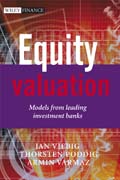
INDICE: Foreword by Abby Josef Cohen, Goldman Sachs s share price performance 2005-2007. 5. Monte Carlo FCFF Models. 5.1 Monte Carlo simulation: The idea. 5.2 Monte Carlo simulation with Risk. 5.2.1 Monte Carlo simulation with one stochastic variable. 5.2.2 Monte Carlo simulation with several stochastic variables. 6. Disclaimer. References. PART III: HOLT CASH FLOW RETURN ON INVESTMENT (CFROI) BEYOND EARNINGS: A USER?S GUIDE TO EXCESS RETURN MODELS (CREDIT SUISSE) (TOM LARSEN AND DAVID HOLLAND). 7. Introduction. 8. From Accounting to Economics - Part I. 9. From Economics to Valuation - Part I. 10. Where does Accounting go Wrong? 11. From Accounting to Economics: CFROI. 11.1 The basics. 11.2CFROI adjustments using Vodafones Match 2005 annual report. 12. Gross Investment. 12.1 Depreciating assets. 12.2 Adjusted gross plant. 12.2.1 Inflation adjustment. 12.2.2 Calculation of the inflation adjustment. 12.3 Capitalized operating leases. 12.4 Capitalized research and development. 12.5 Gross plant recaptured. 13. Depreciating assets. 14. Non-depreciating assets. 14.1 Current assets less inventory. 14.2 Current non-debt liabilities. 14.3 Inventory inflation adjustment. 14.4 Inflation adjusted land. 14.5 Other tangible assets. 14.6 Aword on non-depreciating non-goodwill intangible assets. 15. Project life. 15.1 Gross plant project life. 15.2 Capitalized leases. 15.3 Capitalized R funds. 19.10 Net operating profit after tax (NOPAT). 19.11 Economic profit. 19.12 EP or CFROI? 20. From Economics to Valuation - Part II. 20.1 General rules. 20.1.1 Market value added. 20.1.2 CFROI. 20.2 A word on debt. 21. Valuation. 21.1CFROI valuation: General framework. 21.2 Understanding project returns. 21.3 The residual period. 21.4 CFROI residual period approach. 21.5 Economic profitvaluation: General framework. 21.6 Valuation of Vodafone. 21.7 EP or CFROI? 21.8 A final word. Appendix 1: Vodfone Financial Statements and Relevant Notes for CFROI Calculation. Appendix 2: Additional Notes from Vodafone Annual Report for EP Calcluation. PART IV: MORGAN STANLEY MODELWARES APPROACH TO INTRINSICVALUE: FOCUSING ON RISK-REWARD TRADE-OFFS (TREVOR S. HARRIS, JULIET ESTRIDGE AND DORON NISSIM). 22. Introduction. 23. Linking Fundamental Analysis to the Inputs of the Valuation Model. 24. Our Valuation Framework. 25. Linking Business Activity to Intrinsic Value: The ModelWare Profitability Tree. 26. ModelWareIntrinsic Value Approach. 27. Treatment of Key Inputs. 28. The Cost of Capital. 29. Summary and Conclusions. PART V: UBS VCAM AND EGQ REGRESSION BASED VALUATION (DAVID BIANCO). 30. Introducing ‘EGQ’ - Where Intrinsic Methods and Empirical Techniques Meet. 31. A Quick Guide to DCF and Economic Profit Analysis. 31.1 Powerful analytical frameworks, but not a complete solution. 31.2 Dynamics of economic profit analysis. 31.3 ‘Unadulterated EVA’. 31.4 Value dynamic 1:ROIC. 31.5 Value dynamic 2: Invested capital. 31.6 Value dynamic 3: WACC. 31.7 Dynamic 4: The value creation horizon. 31.8 Combining all four value dynamics: EGQ. 31.8.1 EGQ vs. PVGO. 31.8.2 The search for the ultimate valuation methodology. 32. Regression-based Valuation. 33. UBS Economic Growth Quotient. 33.1 The EGQ calcluation. 33.2 EGQ special attributes. 34 UBS EGQ Regression Valuation. 34.1 Intrinsic meets relative valuation. 34.2 EGQ regressions: Relativevaluation theatre. 34.3 EGQ regressions: A layered alpha framework. 34.4 Y-intercept indicates cost of capital. 34.5 Slope vs. Y-intercept indicated style.34.6 Emergent valuation. 34.7 Why regress EGQ vs. EV/NOPAT? 34.8 Think opposite when under the X-axis. 35. Understanding Regressions. 35.1 Key takeaways. 35.2 The line - What is the relationship? 35.3 The explanatory power or strength of the relationship. 35.4 Reliability or confidence in the quantified relationship. 35.5 Regression outliers. 35.6 Beware of outliers in EGQ regressions. 36. Appendix Discussions. 36.1 EGQs muted sensitivity to assumed WACC. 36.2 EV/IC vs. ROIC/WACC regressions. 36.3 PE vs. EPS growth regressions or PEG ratios. 36.4 Return metrics: ROIC vs. CFROI. 36.5 Accrual vs. cash flow return measures. 36.6 ROIC vs. CFROI. 36.7 Adjusting invested capital important, but not for EGQ. PART VI: LEVERAGE BUYOUT (LBO) MODELS (JAN VIEBIG, DANIEL STILLIT ANDTHORSTEN PODDIG). 37. Introduction. 38. Leveraged Buyouts. 39. IRRs and the Structure of LBO Models. 40. Assumptions of LBO Models. 41. Example: Continental AG. 41.1 Background. 41.2 LBO modeling approach ? Appropriate level of detail. 41.3 Key LBO parameters. 41.4 Step-by-step walk through the model. 42. A Word of Caution. References. PART VII: VALUATION 101: APPROACHES AND ALTERNATIVES (PROFESSOR ASWATH DAMODARAN). 43. Overview of Valuation. 44. Discounted CashFlow Valuation. 44.1 Essence of discounted cash flow valuation. 44.2 Discounted rate adjustment models. 44.3 Certainty equivalent models. 44.4 Excess return models. 44.5 Adjusted present value models. 44.6 Value enhancement in the DCF world. 45. Liquidation and Accounting Valuation. 45.1 Book value based valuation. 45.2 Liquidation valuation. 45.3 Value enhancement in the accounting world. 46. Relative Valuation. 46.1 Steps in relative valuation. 46.2 Basis for approach. 46.3 Standardized values and multiples. 46.4 Determinants of multiples. 46.5 Comparable firms. 46.6 Controlling for differences across firms. 46.7 Value enhancement in the relative valuation world. 47. Real Option Valuation. 47.1 Basis for approach. 47.2 The essence of real options. 47.3 Examples of real options. 47.4 Value enhancement in the real options world. 48. Closing Thoughts on Value Enhancement. PART VIII: VALUATION IN THEORY (ARMIN VARMAZ, THORSTEN PODDIG AND JAN VIEBIG). 49. Motivation. 50. Valuation in Theory: The Valuation of a Single Asset. 50.1 Certain cash flows. 50.2 Uncertain cash flows. 50.3 Risk premium. 50.4 Certainty equivalents and utility-based valuation. 50.5 Risk neutral probabilities. 51. Descriptive Models. 52. Outlook: The Multi Asset Valuation and Allocation Case.
- ISBN: 978-0-470-03149-0
- Editorial: John Wiley & Sons
- Encuadernacion: Cartoné
- Páginas: 472
- Fecha Publicación: 18/04/2008
- Nº Volúmenes: 1
- Idioma: Inglés
